Mybatis源码分析(七)MapperMethod的INSERT分析
| 阿里云国内75折 回扣 微信号:monov8 |
| 阿里云国际,腾讯云国际,低至75折。AWS 93折 免费开户实名账号 代冲值 优惠多多 微信号:monov8 飞机:@monov6 |
目录
- 官网mybatis – MyBatis 3 | 简介
- 参考书籍《通用源码阅读指导书MyBatis源码详解》 易哥
- 参考文章Mybatis源码解析
- CSDNMybatis源码分析_长安不及十里的博客-CSDN博客
- 掘金稀土掘金
- 语雀文档地址Mybatis 源码分析
- 个人博客地址mybatis – 疯狂的程序员
上一篇文章我们介绍了Mapper的接口代理这篇文章我们来介绍一下具体的执行过程
动态代理过程的执行方法invoke
MapperProxy
@Override
public Object invoke(Object proxy, Method method, Object[] args) throws Throwable {
try {
// 继承自Object的方法
if (Object.class.equals(method.getDeclaringClass())) {
// 直接执行原有方法
return method.invoke(this, args);
} else if (method.isDefault()) { // 默认方法
// 执行默认方法
return cachedInvoker(method).invoke(proxy, method, args, sqlSession);
}
} catch (Throwable t) {
throw ExceptionUtil.unwrapThrowable(t);
}
}
private MapperMethodInvoker cachedInvoker(Method method) throws Throwable {
try {
return MapUtil.computeIfAbsent(methodCache, method, m -> {
// 默认方法调用
if (m.isDefault()) {
try {
if (privateLookupInMethod == null) {
return new DefaultMethodInvoker(getMethodHandleJava8(method));
} else {
return new DefaultMethodInvoker(getMethodHandleJava9(method));
}
} catch (IllegalAccessException | InstantiationException | InvocationTargetException
| NoSuchMethodException e) {
throw new RuntimeException(e);
}
}
// 普通方法调用
else {
return new PlainMethodInvoker(new MapperMethod(mapperInterface, method, sqlSession.getConfiguration()));
}
});
} catch (RuntimeException re) {
Throwable cause = re.getCause();
throw cause == null ? re : cause;
}
}
MapperMethodInvoker的接口实现DefaultMethodInvoker与PlainMethodInvoker
PlainMethodInvoker
private static class PlainMethodInvoker implements MapperMethodInvoker {
private final MapperMethod mapperMethod;
public PlainMethodInvoker(MapperMethod mapperMethod) {
super();
this.mapperMethod = mapperMethod;
}
// 调用方法
@Override
public Object invoke(Object proxy, Method method, Object[] args, SqlSession sqlSession) throws Throwable {
return mapperMethod.execute(sqlSession, args);
}
}
接着调用具体的执行方法execute方法我们具体里看看他的执行过程
MapperMethod
/**
* 执行映射接口中的方法
* @param sqlSession sqlSession接口的实例通过它可以进行数据库的操作
* @param args 执行接口方法时传入的参数
* @return 数据库操作结果
*/
public Object execute(SqlSession sqlSession, Object[] args) {
Object result;
switch (command.getType()) { // 根据SQL语句类型执行不同操作
case INSERT: { // 如果是插入语句
// 将参数顺序与实参对应好
Object param = method.convertArgsToSqlCommandParam(args);
// 执行操作并返回结果
result = rowCountResult(sqlSession.insert(command.getName(), param));
break;
}
case UPDATE: { // 如果是更新语句
// 将参数顺序与实参对应好
Object param = method.convertArgsToSqlCommandParam(args);
// 执行操作并返回结果
result = rowCountResult(sqlSession.update(command.getName(), param));
break;
}
case DELETE: { // 如果是删除语句MappedStatement
// 将参数顺序与实参对应好
Object param = method.convertArgsToSqlCommandParam(args);
// 执行操作并返回结果
result = rowCountResult(sqlSession.delete(command.getName(), param));
break;
}
case SELECT: // 如果是查询语句
if (method.returnsVoid() && method.hasResultHandler()) { // 方法返回值为void且有结果处理器
// 使用结果处理器执行查询
executeWithResultHandler(sqlSession, args);
result = null;
} else if (method.returnsMany()) { // 多条结果查询
result = executeForMany(sqlSession, args);
} else if (method.returnsMap()) { // Map结果查询
result = executeForMap(sqlSession, args);
} else if (method.returnsCursor()) { // 游标类型结果查询
result = executeForCursor(sqlSession, args);
} else { // 单条结果查询
Object param = method.convertArgsToSqlCommandParam(args);
result = sqlSession.selectOne(command.getName(), param);
if (method.returnsOptional()
&& (result == null || !method.getReturnType().equals(result.getClass()))) {
result = Optional.ofNullable(result);
}
}
break;
case FLUSH: // 清空缓存语句
result = sqlSession.flushStatements();
break;
default: // 未知语句类型抛出异常
throw new BindingException("Unknown execution method for: " + command.getName());
}
if (result == null && method.getReturnType().isPrimitive() && !method.returnsVoid()) {
// 查询结果为null,但返回类型为基本类型。因此返回变量无法接收查询结果抛出异常。
throw new BindingException("Mapper method '" + command.getName()
+ " attempted to return null from a method with a primitive return type (" + method.getReturnType() + ").");
}
return result;
}
下面我们具体来分析一下执行流程
一 INSERT 语句
这里我们以insert语句开头更新删除都差不多查询下一篇文章我们详细介绍
MapperMethod
// 如果是插入语句
case INSERT: {
// 将参数顺序与实参对应好
Object param = method.convertArgsToSqlCommandParam(args);
// 执行操作并返回结果
result = rowCountResult(sqlSession.insert(command.getName(), param));
break;
}
- 第一步将参数顺序与实参对应好
- 交给Sqlsession执行返回结果
我们来看看他是如何转换参数的首先看看ParamNameResolver对象
ParamNameResolver
//<li>aMethod(@Param("M") int a, @Param("N") int b) -> {{0, "M"}, {1, "N"}}</li>
//<li>aMethod(int a, int b) -> {{0, "0"}, {1, "1"}}</li>
//aMethod(int a, RowBounds rb, int b) -> {{0, "0"}, {2, "1"}}</li>
// 方法入参的参数次序表。键为参数次序值为参数名称或者参数@Param注解的值
private final SortedMap<Integer, String> names;
// 该方法入参中是否含有@Param注解
private boolean hasParamAnnotation;
/**
* 参数名解析器的构造方法
* @param config 配置信息
* @param method 要被分析的方法
*/
public ParamNameResolver(Configuration config, Method method) {
// 获取参数类型列表
final Class<?>[] paramTypes = method.getParameterTypes();
// 准备存取所有参数的注解是二维数组
final Annotation[][] paramAnnotations = method.getParameterAnnotations();
final SortedMap<Integer, String> map = new TreeMap<>();
int paramCount = paramAnnotations.length;
// 循环处理各个参数
for (int paramIndex = 0; paramIndex < paramCount; paramIndex++) {
if (isSpecialParameter(paramTypes[paramIndex])) {
// 跳过特别的参数
continue;
}
// 参数名称
String name = null;
for (Annotation annotation : paramAnnotations[paramIndex]) {
// 找出参数的注解
if (annotation instanceof Param) {
// 如果注解是Param
hasParamAnnotation = true;
// 那就以Param中值作为参数名
name = ((Param) annotation).value();
break;
}
}
if (name == null) {
// 否则保留参数的原有名称
if (config.isUseActualParamName()) {
name = getActualParamName(method, paramIndex);
}
if (name == null) {
// 参数名称取不到则按照参数index命名
name = String.valueOf(map.size());
}
}
map.put(paramIndex, name);
}
names = Collections.unmodifiableSortedMap(map);
}
我们可以看到经过ParamNameResolver的构造器对参数进行解析比如aMethod(@Param(“M”) int a, @Param(“N”) int b) -> {{0, “M”}, {1, “N”}} 解析好放入name中
测试代码
@Test
public void InsertTest(){
// 第一阶段MyBatis的初始化阶段
String resource = "mybatis-config.xml";
// 得到配置文件的输入流
InputStream inputStream = null;
try {
inputStream = Resources.getResourceAsStream(resource);
} catch (IOException e) {
e.printStackTrace();
}
// 得到SqlSessionFactory
SqlSessionFactory sqlSessionFactory = new SqlSessionFactoryBuilder().build(inputStream);
// 第二阶段数据读写阶段
try (SqlSession session = sqlSessionFactory.openSession()) {
// 找到接口对应的实现
UserMapper userMapper = session.getMapper(UserMapper.class);
// 组建查询参数
User userParam = new User();
userParam.setSchoolname("Sunny School");
// 调用接口展开数据库操作
int insert = userMapper.insert(userParam);
System.out.println(insert);
}
}
1.1 参数的对应解析convertArgsToSqlCommandParam
- 打上断点调试一手我们可以看到首先判断SqlCommand的类型是INSERT
- 通过convertArgsToSqlCommandParam方法转换参数下面我们来看看具体的convertArgsToSqlCommandParam的方法这就需要ParamNameResolver的方法来帮助解析
ParamNameResolver
// 获取参数
public Object getNamedParams(Object[] args) {
final int paramCount = names.size();
if (args == null || paramCount == 0) {
return null;
}
// 不是注解且参数个数为1 aMethod(@Param("M") int a, @Param("N") int b) -> {{0, "M"}, {1, "N"}}
else if (!hasParamAnnotation && paramCount == 1) {
// 就返回第一个值
Object value = args[names.firstKey()];
// 判断是否需要返回集合类型
return wrapToMapIfCollection(value, useActualParamName ? names.get(0) : null);
}
// 注解的方式
else {
final Map<String, Object> param = new ParamMap<>();
int i = 0;
for (Map.Entry<Integer, String> entry : names.entrySet()) {
param.put(entry.getValue(), args[entry.getKey()]);
// add generic param names (param1, param2, ...)
final String genericParamName = GENERIC_NAME_PREFIX + (i + 1);
// ensure not to overwrite parameter named with @Param
if (!names.containsValue(genericParamName)) {
param.put(genericParamName, args[entry.getKey()]);
}
i++;
}
return param;
}
}
我们可以看到通过convertArgsToSqlCommandParam的调用参数完成了对应的转换
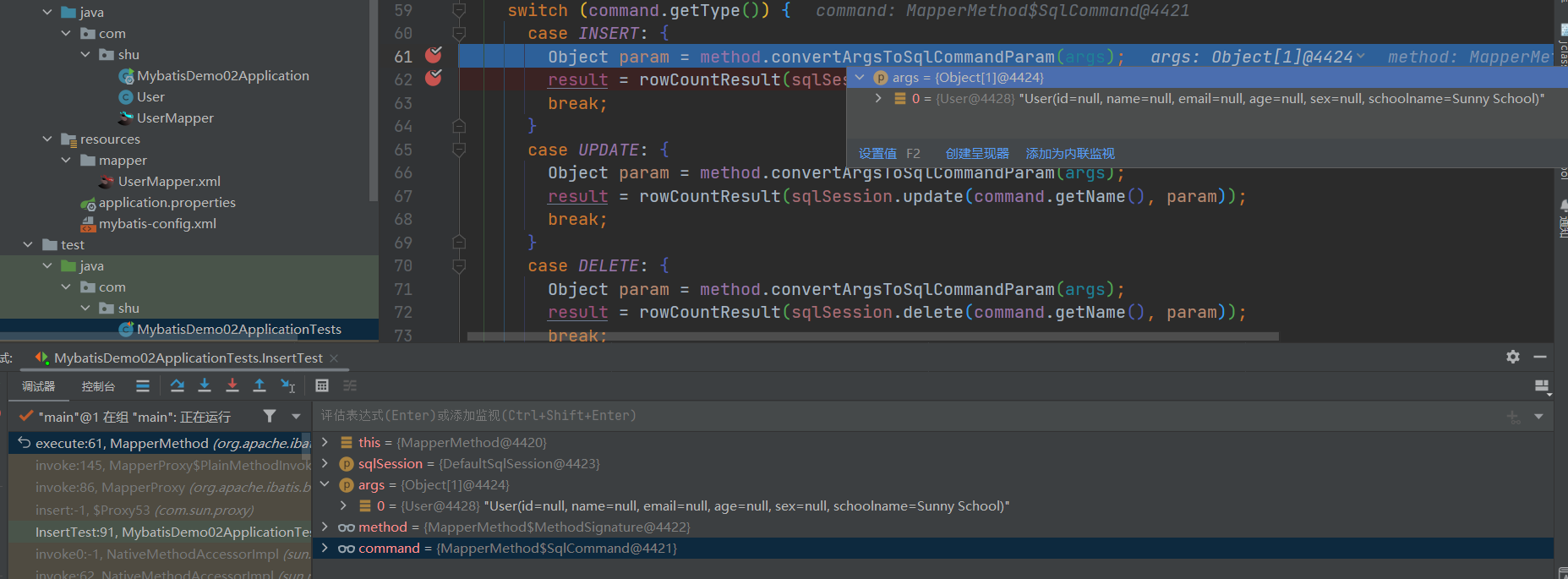
注意这注解方式传递的参数转换有点不一样

1.2 ID获取对应的MappedStatement
经过上面的处理我们完成了对参数的转换下面交给Sqlseeeion 具体执行
- 下面的步骤通过id获取到我们解析好的Sql语句比如com.shu.UserMapper.insert
- 交给相应的执行器执行sql语句

DefaultSqlSession
// 执行语句的插入
@Override
public int insert(String statement, Object parameter) {
return update(statement, parameter);
}
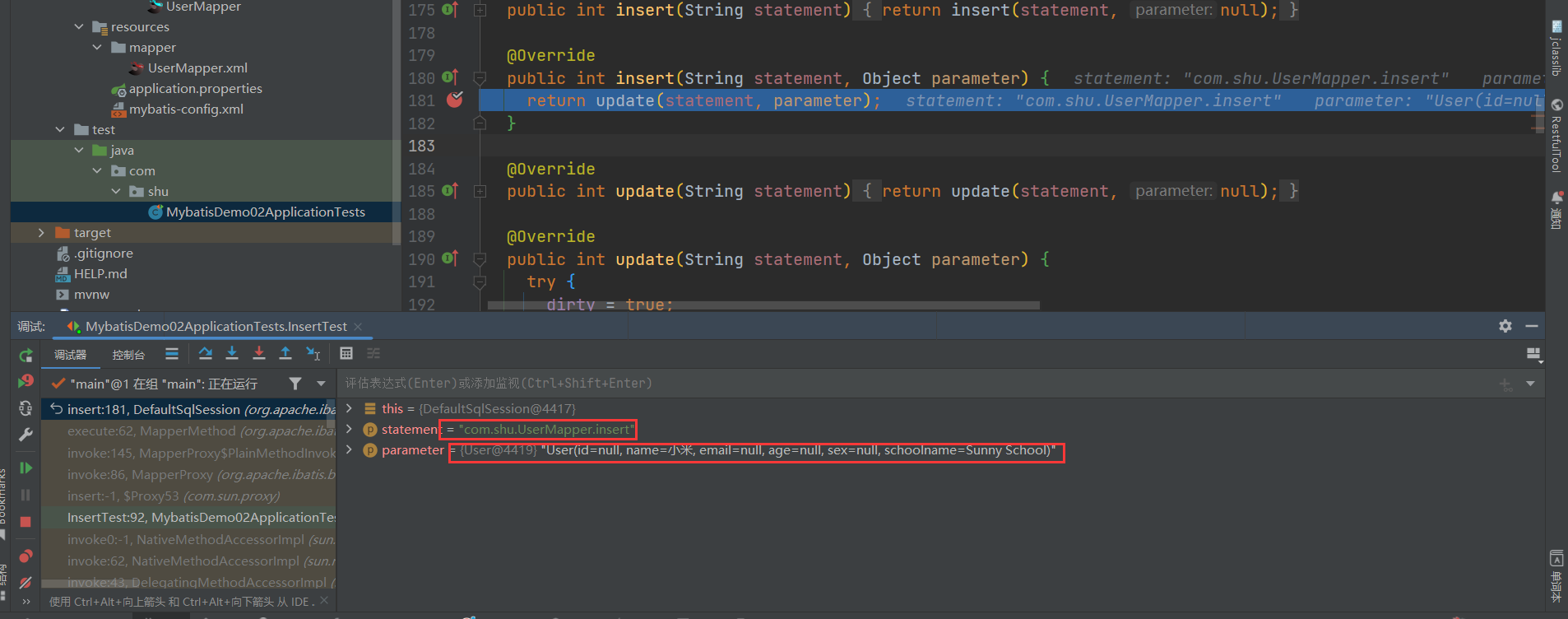
具体的执行通过id获取具体的MappedStatement
DefaultSqlSession
@Override
public int update(String statement, Object parameter) {
try {
// 是否缓存过了
dirty = true;
// 通过id获取执行的sql语句
MappedStatement ms = configuration.getMappedStatement(statement);
// 把具体的执行sql与参数交给执行器执行返回执行结果
return executor.update(ms, wrapCollection(parameter));
} catch (Exception e) {
throw ExceptionFactory.wrapException("Error updating database. Cause: " + e, e);
} finally {
ErrorContext.instance().reset();
}
}
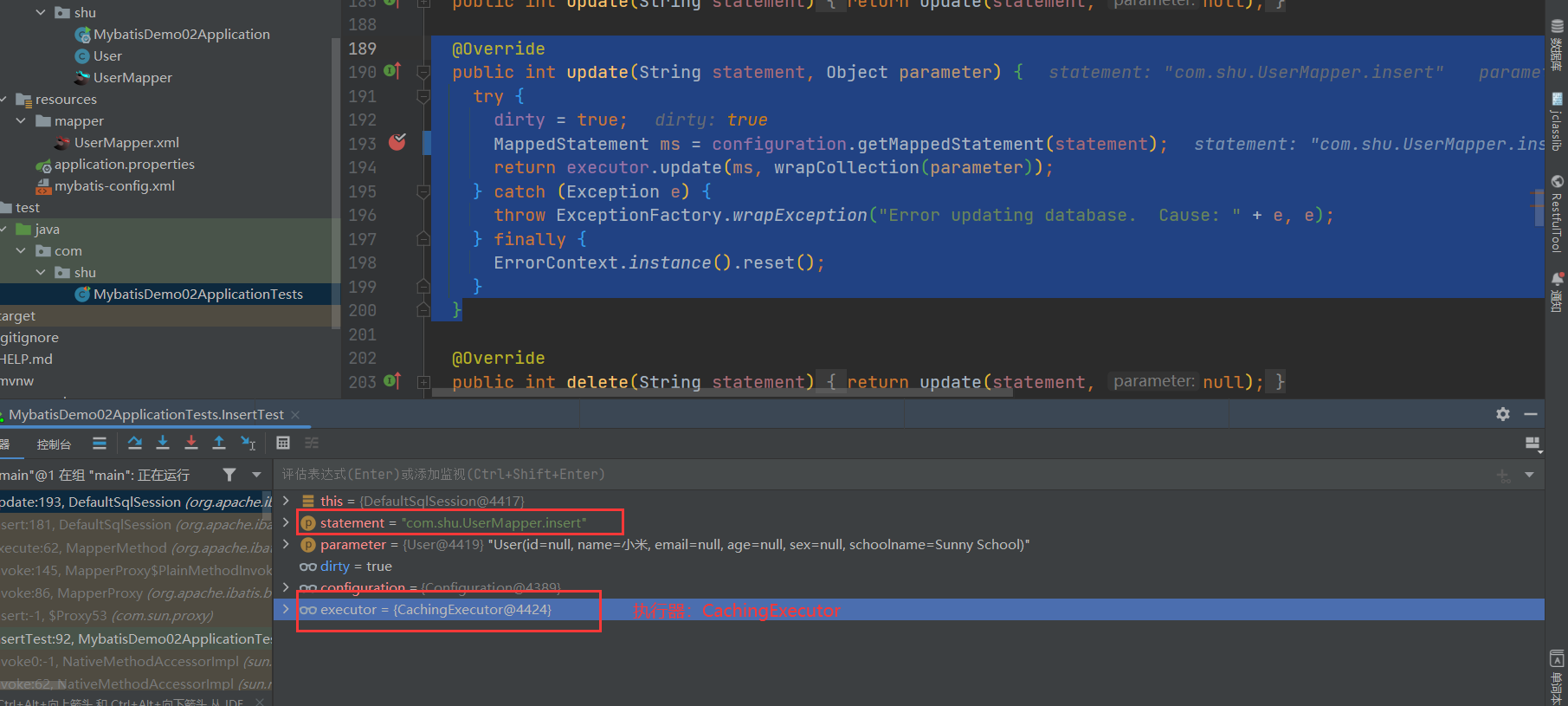
- 通过id获取需要执行的Sql语句以及配置信息MappedStatement的构建参考前面的解析。
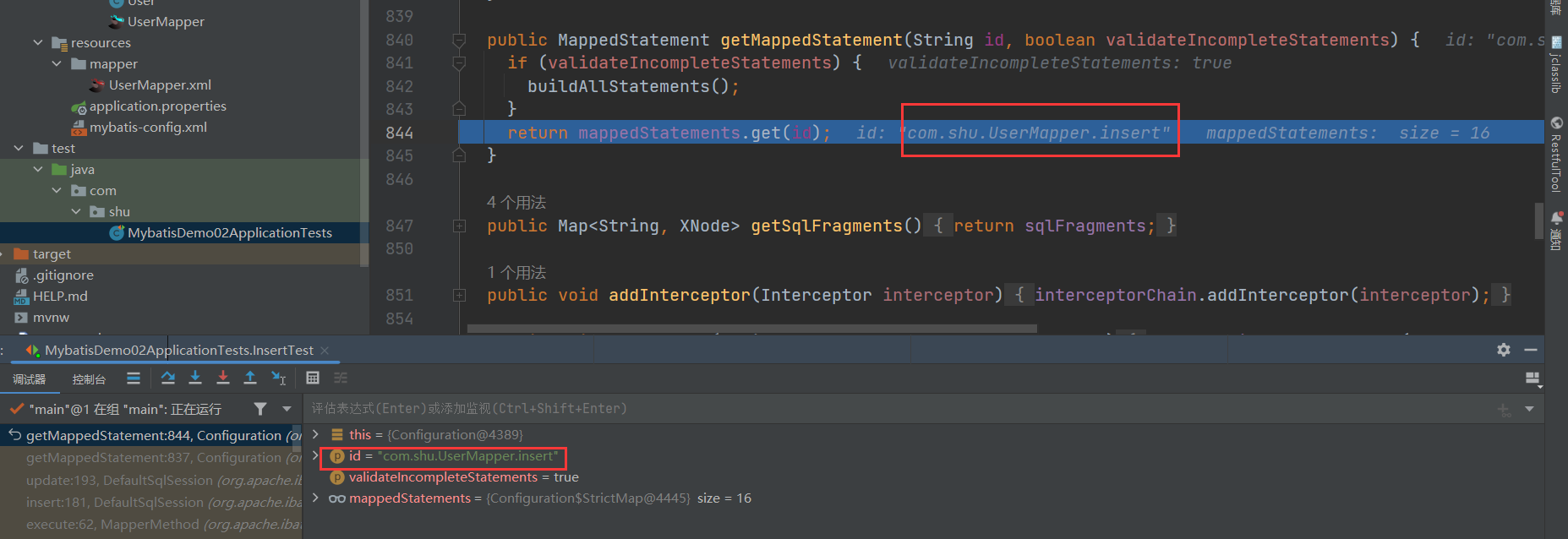
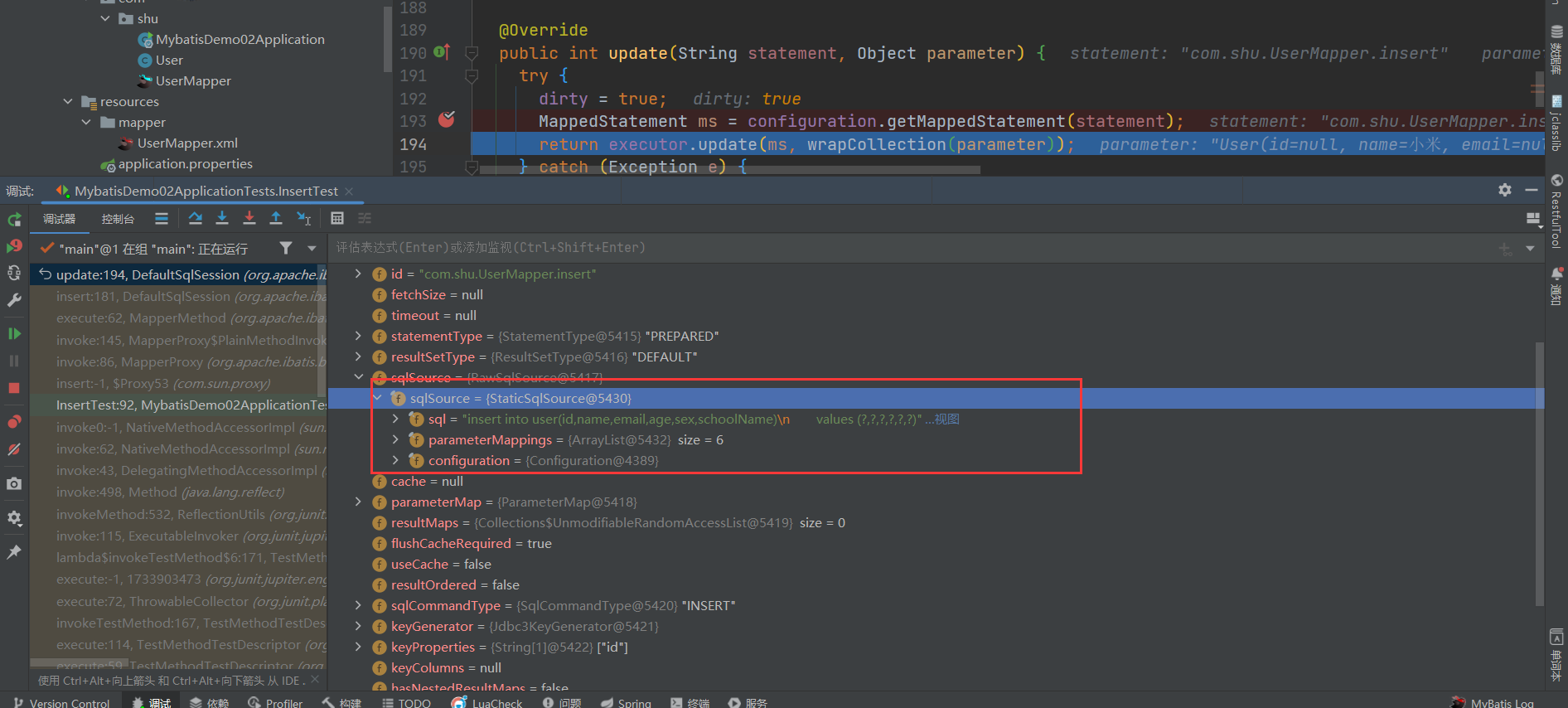
1.3 MappedStatement交给执行器执行
- 在上面我们通过id获取到了configuration中具体的MappedStatement
- 下面我们交给具体的执行器负责处理对应的SQL语句而Executor采用模板模式进行设计
首先我们来看看执行器

- ExecutorType.SIMPLE默认执行器
可以返回自增键只需要在mapper文件中增加属性 useGeneratedKeys=“true” keyProperty=“productId”那么自增键会在事务提交后自动设置到传入的 user对象中
这个类型不做特殊的事情它只为每个语句创建一个PreparedStatement。
- ExecutorType.REUSE
这种类型将重复使用PreparedStatements。
- ExecutorType.BATCH
这个类型批量更新且必要地区别开其中的select 语句确保动作易于理解。
// 在我们这默认使用CachingExecutor
- 更新数据库数据INSERT/UPDATE/DELETE三种操作都会调用该方法
执行器的创建在调用SqlSessionFactory#openSession方法是创建可以看看前面的文章利用装饰器模式CachingExecutor原来的执行器进行增强
SqlSession
/**
* 从数据源中获取SqlSession对象
* @param execType 执行器类型
* @param level 事务隔离级别
* @param autoCommit 是否自动提交事务
* @return SqlSession对象
*/
private SqlSession openSessionFromDataSource(ExecutorType execType, TransactionIsolationLevel level, boolean autoCommit) {
Transaction tx = null;
try {
// 找出要使用的指定环境
final Environment environment = configuration.getEnvironment();
// 从环境中获取事务工厂
final TransactionFactory transactionFactory = getTransactionFactoryFromEnvironment(environment);
// 从事务工厂中生产事务
tx = transactionFactory.newTransaction(environment.getDataSource(), level, autoCommit);
// 创建执行器
final Executor executor = configuration.newExecutor(tx, execType);
// 创建DefaultSqlSession对象
return new DefaultSqlSession(configuration, executor, autoCommit);
} catch (Exception e) {
closeTransaction(tx); // may have fetched a connection so lets call close()
throw ExceptionFactory.wrapException("Error opening session. Cause: " + e, e);
} finally {
ErrorContext.instance().reset();
}
}
- 因为在执行器的创建过程中利用装饰器模式对原来的执行器进行增加因此我们首先看看CachingExecutor
CachingExecutor
// 事务缓存管理器
private final TransactionalCacheManager tcm = new TransactionalCacheManager();
/**
* 更新数据库数据INSERT/UPDATE/DELETE三种操作都会调用该方法
* @param ms 映射语句
* @param parameterObject 参数对象
* @return 数据库操作结果
* @throws SQLException
*/
@Override
public int update(MappedStatement ms, Object parameterObject) throws SQLException {
// 根据要求判断语句执行前是否要清除二级缓存如果需要清除二级缓存
flushCacheIfRequired(ms);
return delegate.update(ms, parameterObject);
}
/**
* 根据要求判断语句执行前是否要清除二级缓存如果需要清除二级缓存
* 注意默认情况下非SELECT语句的isFlushCacheRequired方法会返回true
* @param ms MappedStatement
*/
private void flushCacheIfRequired(MappedStatement ms) {
// 获取MappedStatement对应的缓存
Cache cache = ms.getCache();
if (cache != null && ms.isFlushCacheRequired()) { // 存在缓存且该操作语句要求执行前清除缓存
// 清除事务中的缓存
tcm.clear(cache);
}
}
这里设涉及到一二级缓存我们后面详细介绍先跳过。
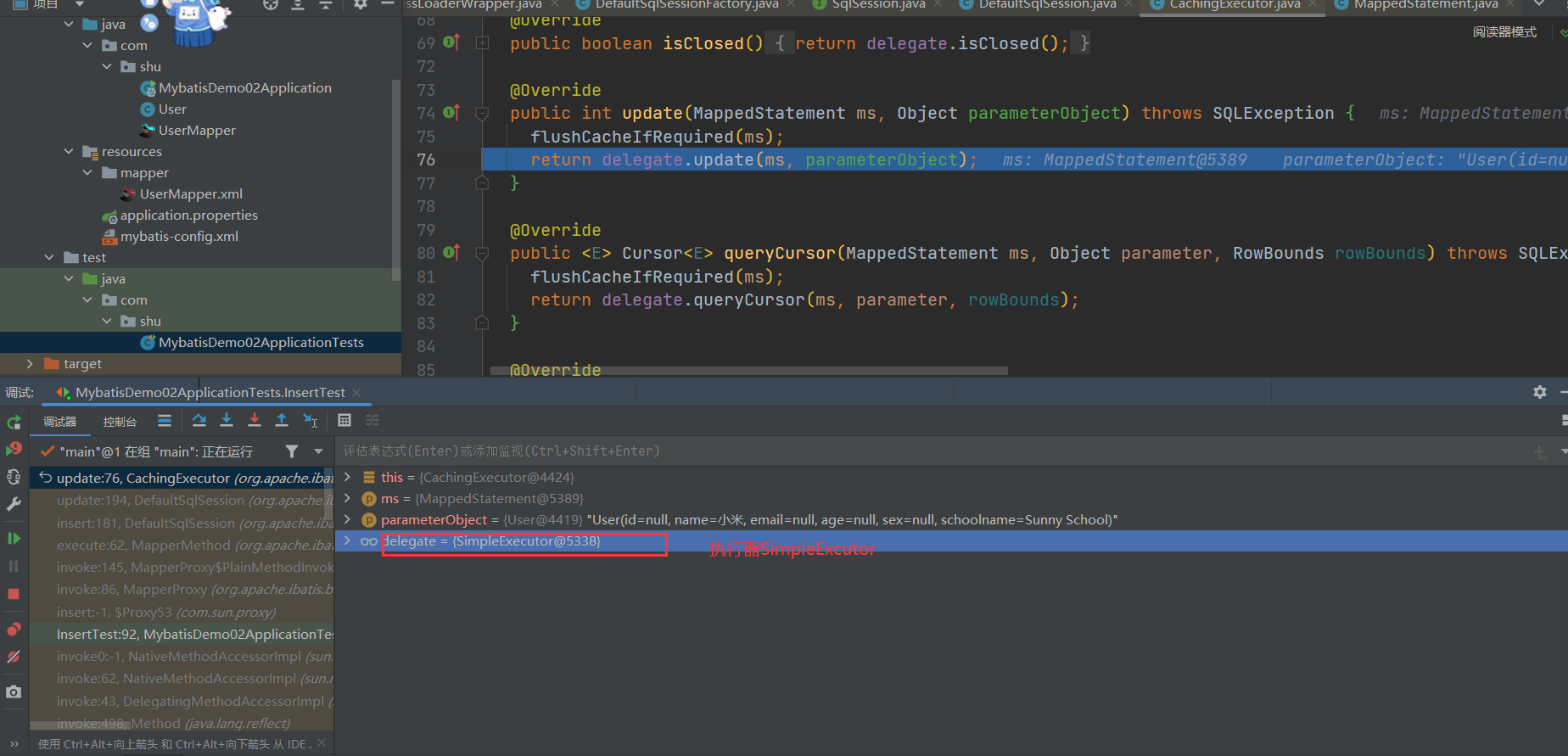
- 更新数据库数据INSERT/UPDATE/DELETE三种操作都会调用该方法
BaseExecutor
/**
* 更新数据库数据INSERT/UPDATE/DELETE三种操作都会调用该方法
* @param ms 映射语句
* @param parameter 参数对象
* @return 数据库操作结果
* @throws SQLException
*/
@Override
public int update(MappedStatement ms, Object parameter) throws SQLException {
ErrorContext.instance().resource(ms.getResource())
.activity("executing an update").object(ms.getId());
if (closed) {
// 执行器已经关闭
throw new ExecutorException("Executor was closed.");
}
// 清理本地缓存
clearLocalCache();
// 返回调用子类进行操作
return doUpdate(ms, parameter);
}
默认的执行器是SimpleExecutor
// 调用SimpleExecutor的方法
@Override
public int doUpdate(MappedStatement ms, Object parameter) throws SQLException {
Statement stmt = null;
try {
// 获取配置文件
Configuration configuration = ms.getConfiguration();
// 处理器
StatementHandler handler = configuration.newStatementHandler(this, ms, parameter, RowBounds.DEFAULT, null, null);
stmt = prepareStatement(handler, ms.getStatementLog());
return handler.update(stmt);
} finally {
closeStatement(stmt);
}
}
1.4 不同的执行器获取不同的StatementHandler
StatementHandler 是四大组件中最重要的一个对象负责操作 Statement 对象与数据库进行交流
- 首先我们来看看StatementHandler接口
StatementHandler
// 从Connection中创建一个Statement
Statement prepare(Connection connection, Integer transactionTimeout)
throws SQLException;
// 为Statement绑定实参
void parameterize(Statement statement)
throws SQLException;
// 批量执行操作
void batch(Statement statement)
throws SQLException;
// 执行增、删、改操作
int update(Statement statement)
throws SQLException;
// 执行查找操作返回list
<E> List<E> query(Statement statement, ResultHandler resultHandler)
throws SQLException;
// 执行查询操作返回迭代游标
<E> Cursor<E> queryCursor(Statement statement)
throws SQLException;
// 获取BoundSql对象
BoundSql getBoundSql();
// 获取参数处理器
ParameterHandler getParameterHandler();
- 对应是实现类
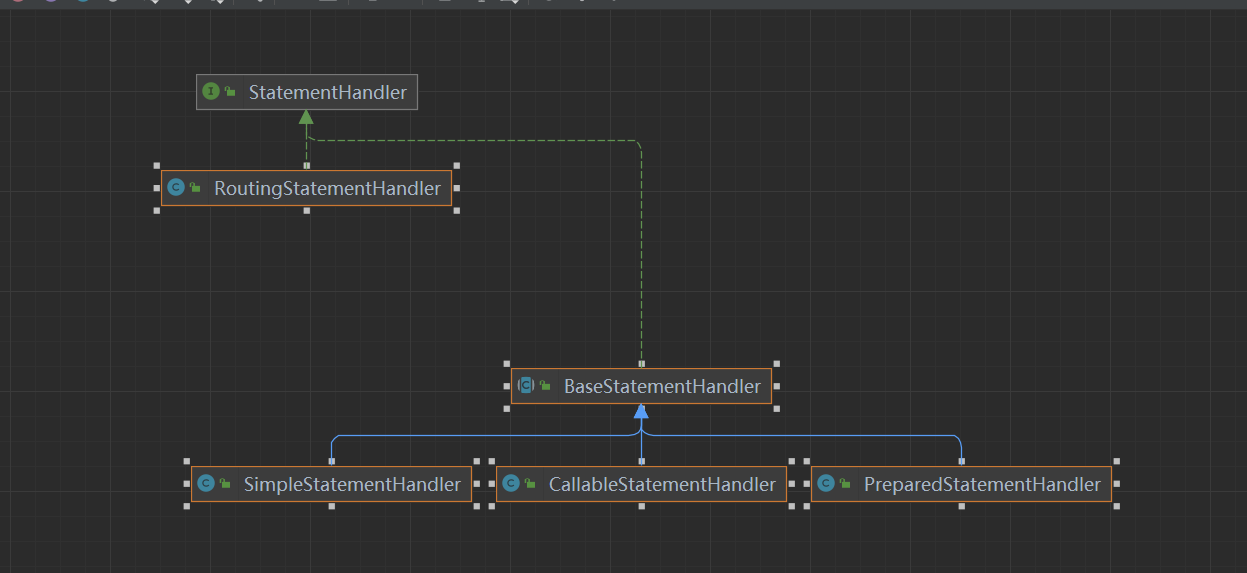
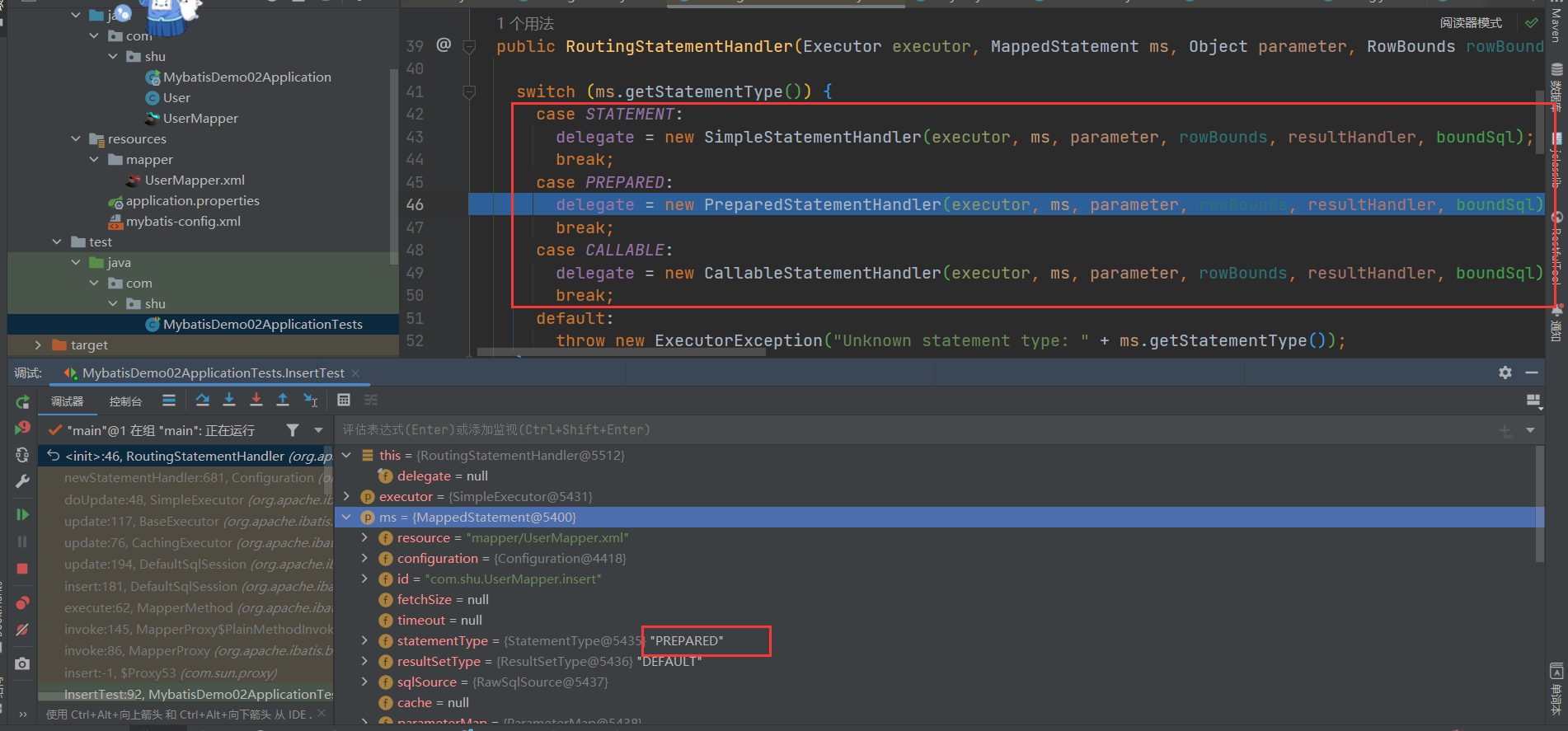
- RoutingStatementHandler: RoutingStatementHandler 并没有对 Statement 对象进行使用只是根据StatementType 来创建一个代理代理的就是对应Handler的三种实现类。在MyBatis工作时,使用的StatementHandler 接口对象实际上就是 RoutingStatementHandler 对象。
- BaseStatementHandler: 是 StatementHandler 接口的另一个实现类.本身是一个抽象类.用于简化StatementHandler 接口实现的难度,属于适配器设计模式体现它主要有三个实现类
- SimpleStatementHandler: 管理 Statement 对象并向数据库中推送不需要预编译的SQL语句。
- PreparedStatementHandler: 管理 Statement 对象并向数据中推送需要预编译的SQL语句。
- CallableStatementHandler管理 Statement 对象并调用数据库中的存储过程。

RoutingStatementHandler
// 根据语句类型选取出的被代理类的对象
private final StatementHandler delegate;
public RoutingStatementHandler(Executor executor, MappedStatement ms, Object parameter, RowBounds rowBounds, ResultHandler resultHandler, BoundSql boundSql) {
// 根据语句类型选择被代理对象
switch (ms.getStatementType()) {
case STATEMENT:
delegate = new SimpleStatementHandler(executor, ms, parameter, rowBounds, resultHandler, boundSql);
break;
case PREPARED:
delegate = new PreparedStatementHandler(executor, ms, parameter, rowBounds, resultHandler, boundSql);
break;
case CALLABLE:
delegate = new CallableStatementHandler(executor, ms, parameter, rowBounds, resultHandler, boundSql);
break;
default:
throw new ExecutorException("Unknown statement type: " + ms.getStatementType());
}
}

这里我们可以看到statementType为PREPARED类型为PreparedStatementHandler但是他调用父类的方法因此我们看看BaseStatementHandler
BaseStatementHandler
/**
* 主要定义了从Connection中获取Statement的方法而对于具体的Statement操作则未定义
*/
public abstract class BaseStatementHandler implements StatementHandler {
// 配置文件
protected final Configuration configuration;
// 对象工厂
protected final ObjectFactory objectFactory;
// 类型注册机
protected final TypeHandlerRegistry typeHandlerRegistry;
// 结果处理器
protected final ResultSetHandler resultSetHandler;
// 参数处理器
protected final ParameterHandler parameterHandler;
// 执行器
protected final Executor executor;
// 隐射语句
protected final MappedStatement mappedStatement;
// 行范围
protected final RowBounds rowBounds;
// 绑定的sql
protected BoundSql boundSql;
}
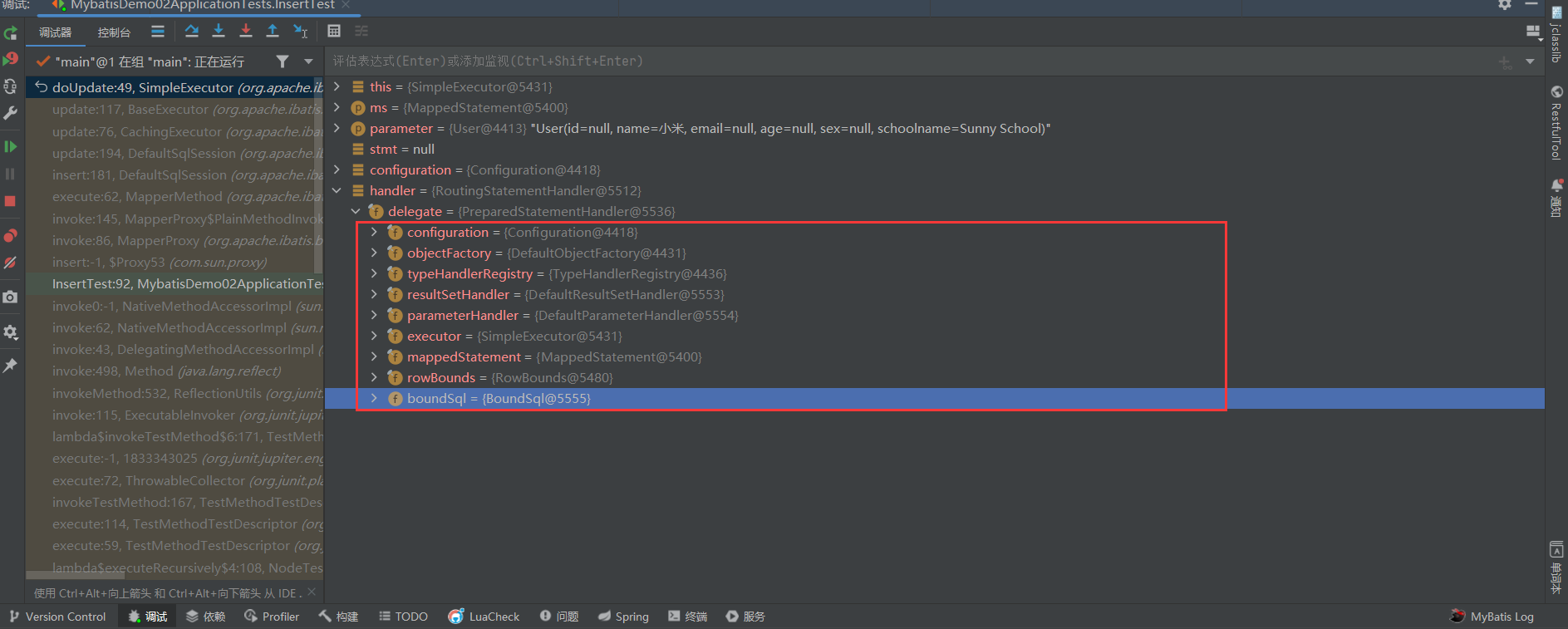
- 再来看看他的构造器方法
BaseStatementHandler
protected BaseStatementHandler(Executor executor, MappedStatement mappedStatement, Object parameterObject, RowBounds rowBounds, ResultHandler resultHandler, BoundSql boundSql) {
// 配置文件
this.configuration = mappedStatement.getConfiguration();
// 执行器
this.executor = executor;
// 隐射语句
this.mappedStatement = mappedStatement;
this.rowBounds = rowBounds;
// 类型处理器
this.typeHandlerRegistry = configuration.getTypeHandlerRegistry();
// 对象工厂
this.objectFactory = configuration.getObjectFactory();
// 在执行是前面传入为null
if (boundSql == null) { // issue #435, get the key before calculating the statement
// 如果是前置主键自增则在这里进行获得自增的键值
generateKeys(parameterObject);
// 获取BoundSql对象
boundSql = mappedStatement.getBoundSql(parameterObject);
}
// 需要绑定的sql
this.boundSql = boundSql;
// 参数处理器
this.parameterHandler = configuration.newParameterHandler(mappedStatement, parameterObject, boundSql);
// 结果处理器
this.resultSetHandler = configuration.newResultSetHandler(executor, mappedStatement, rowBounds, parameterHandler, resultHandler, boundSql);
}
- 在他的构造器中我们需要关注到两个方法generateKeys(parameterObject)方法mappedStatement.getBoundSql(parameterObject)方法首先让我们来看看generateKeys方法
BaseStatementHandler
// 前置自增主键的生成
protected void generateKeys(Object parameter) {
// 从隐射语句中获取KeyGenerator
KeyGenerator keyGenerator = mappedStatement.getKeyGenerator();
ErrorContext.instance().store();
keyGenerator.processBefore(executor, mappedStatement, null, parameter);
ErrorContext.instance().recall();
}
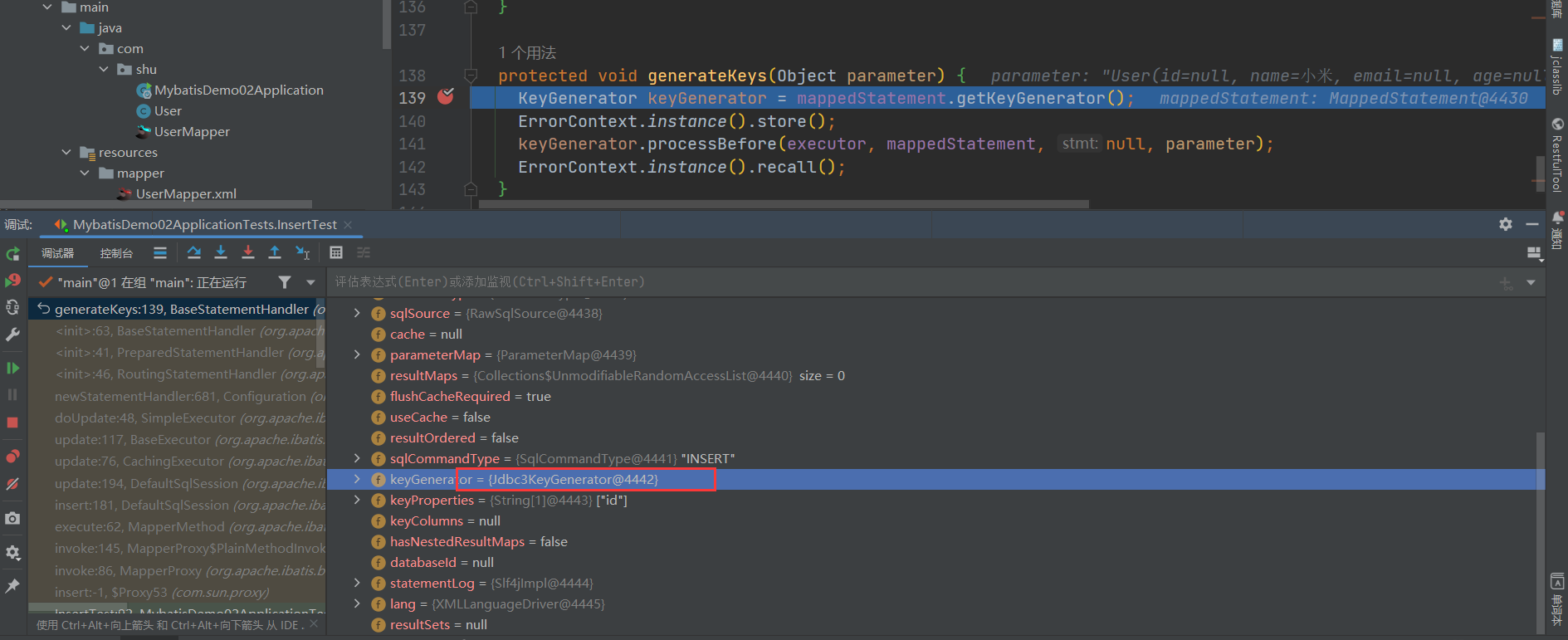
- 我们可以看到用于实现数据插入时主键自增的主键编号生成器有三种实现而决定用那种在于MappedStatement的Builder方法中
MappedStatement
// 全局启用主键生成且是插入语句则设置主键生成器
mappedStatement.keyGenerator = configuration.isUseGeneratedKeys() && SqlCommandType.INSERT.equals(sqlCommandType) ? Jdbc3KeyGenerator.INSTANCE : NoKeyGenerator.INSTANCE;

1.5 根据参数获取BoundSql
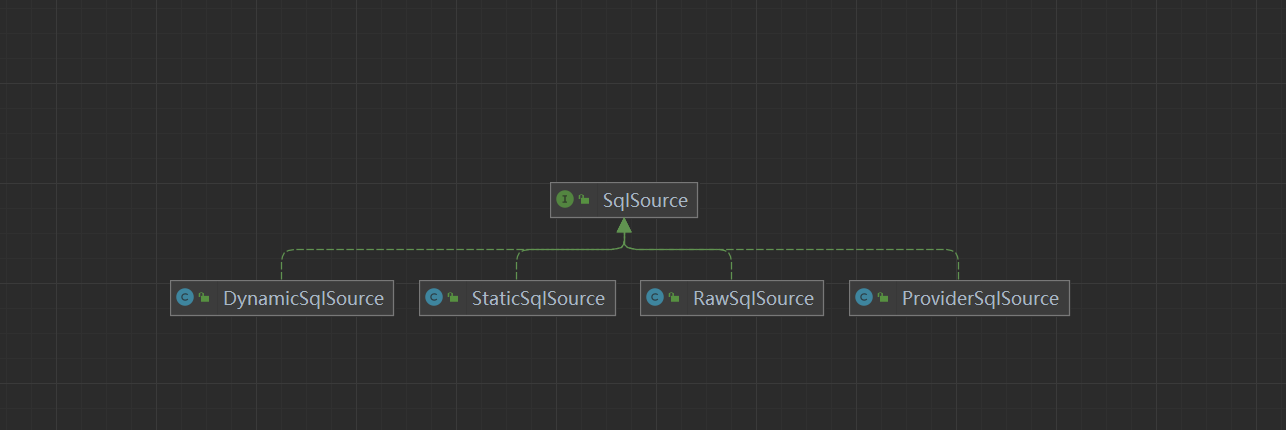
- DynamicSqlSource针对动态 SQL 和 ${} 占位符的 SQL
- RawSqlSource针对 #{}占位符的 SQL
- ProviderSqlSource针对 @*Provider 注解 提供的 SQL
- StaticSqlSource仅包含有 ?占位符的 SQL
- 下面我们来看看getBoundSql的方法获取一个BoundSql对象
MappedStatement
//SQL源码对应于我们所写在配置文件中的SQL语句。包含占位符无法直接执行。可以展开分析就是分行的sql语句text。
private SqlSource sqlSource;
public BoundSql getBoundSql(Object parameterObject) {
// 获取绑定的sql
BoundSql boundSql = sqlSource.getBoundSql(parameterObject);
// 获取参数隐射
List<ParameterMapping> parameterMappings = boundSql.getParameterMappings();
// 判断是否为空或为null
if (parameterMappings == null || parameterMappings.isEmpty()) {
boundSql = new BoundSql(configuration, boundSql.getSql(), parameterMap.getParameterMappings(), parameterObject);
}
// check for nested result maps in parameter mappings (issue #30)
for (ParameterMapping pm : boundSql.getParameterMappings()) {
String rmId = pm.getResultMapId();
if (rmId != null) {
ResultMap rm = configuration.getResultMap(rmId);
if (rm != null) {
hasNestedResultMaps |= rm.hasNestedResultMaps();
}
}
}
return boundSql;
}
/**
* 组建一个BoundSql对象
* @param parameterObject 参数对象
* @return 组件的BoundSql对象
*/
@Override
public BoundSql getBoundSql(Object parameterObject) {
return new BoundSql(configuration, sql, parameterMappings, parameterObject);
}
这里的RawSqlSource为sqlSource的实现类但是他不是最终的执行类StaticSqlSource才是最终的执行类经过经过解析后不存在${}和#{}这两种符号只剩下?符号的SQL语句
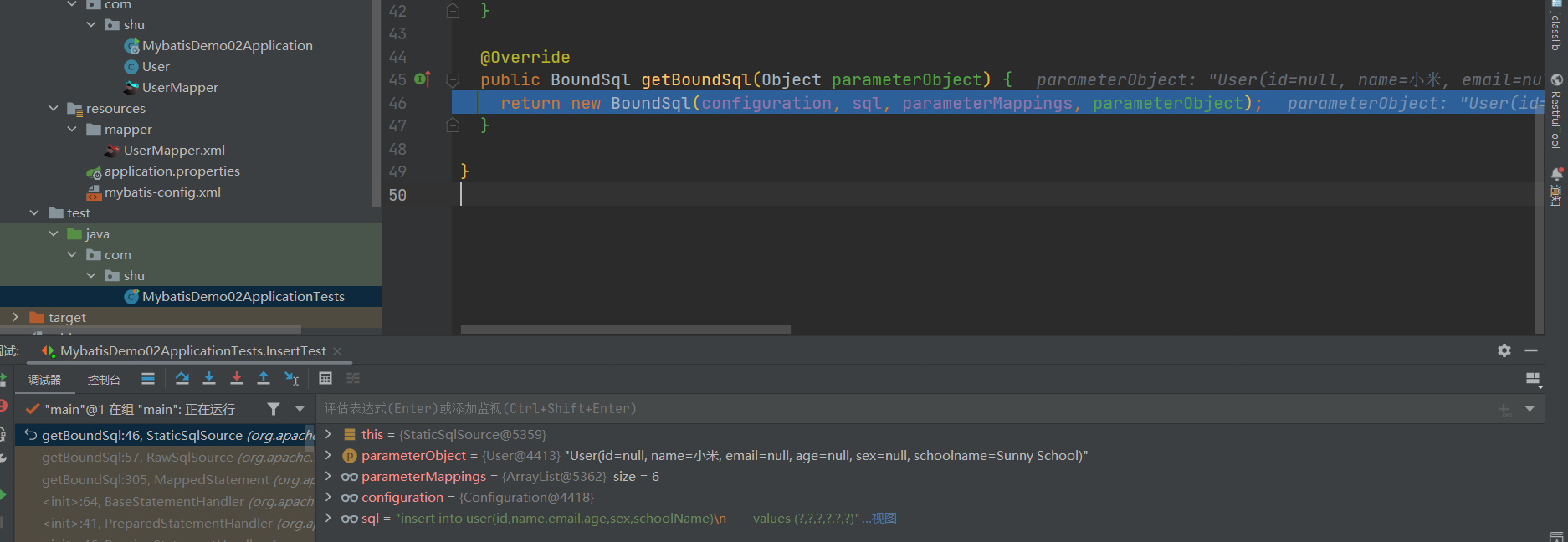
StaticSqlSource
/**
* 组建一个BoundSql对象
* @param parameterObject 参数对象
* @return 组件的BoundSql对象
*/
@Override
public BoundSql getBoundSql(Object parameterObject) {
return new BoundSql(configuration, sql, parameterMappings, parameterObject);
}
我们来看看BoundSql对象首先看看他的成员变量
BoundSql
public class BoundSql {
// 可能含有“?”占位符的sql语句
private final String sql;
// 参数映射列表
private final List<ParameterMapping> parameterMappings;
// 实参对象本身
private final Object parameterObject;
// 实参
private final Map<String, Object> additionalParameters;
// additionalParameters的包装对象
private final MetaObject metaParameters;
}
RawSqlSource在初始化对参数进行处理返回一个StaticSqlSource
RawSqlSource
public RawSqlSource(Configuration configuration, String sql, Class<?> parameterType) {
SqlSourceBuilder sqlSourceParser = new SqlSourceBuilder(configuration);
Class<?> clazz = parameterType == null ? Object.class : parameterType;
// 处理RawSqlSource中的“#{}”占位符得到StaticSqlSource
sqlSource = sqlSourceParser.parse(sql, clazz, new HashMap<>());
}
SqlSourceBuilder
/**
* 将DynamicSqlSource和RawSqlSource中的“#{}”符号替换掉从而将他们转化为StaticSqlSource
* @param originalSql sqlNode.apply()拼接之后的sql语句。已经不包含<if> <where>等节点也不含有${}符号
* @param parameterType 实参类型
* @param additionalParameters 附加参数
* @return 解析结束的StaticSqlSource
*/
public SqlSource parse(String originalSql, Class<?> parameterType, Map<String, Object> additionalParameters) {
// 用来完成#{}处理的处理器
ParameterMappingTokenHandler handler = new ParameterMappingTokenHandler(configuration, parameterType, additionalParameters);
// 通用的占位符解析器用来进行占位符替换
GenericTokenParser parser = new GenericTokenParser("#{", "}", handler);
// 将#{}替换为?的SQL语句
String sql = parser.parse(originalSql);
// 生成新的StaticSqlSource对象
return new StaticSqlSource(configuration, sql, handler.getParameterMappings());
}
到这我们把BaseBuilder 类的实现类全部见到了SqlSourceBuilder负责对Sql的转换处理把他转换成标准的数据库执行SQL这个对Sql的解析过程在下一篇文章会详细介绍我们还是回到getBoundSql
BaseStatementHandler
protected BaseStatementHandler(Executor executor, MappedStatement mappedStatement, Object parameterObject, RowBounds rowBounds, ResultHandler resultHandler, BoundSql boundSql) {
this.configuration = mappedStatement.getConfiguration();
this.executor = executor;
this.mappedStatement = mappedStatement;
this.rowBounds = rowBounds;
this.typeHandlerRegistry = configuration.getTypeHandlerRegistry();
this.objectFactory = configuration.getObjectFactory();
if (boundSql == null) { // issue #435, get the key before calculating the statement
// 如果是前置主键自增则在这里进行获得自增的键值
generateKeys(parameterObject);
// 获取BoundSql对象
boundSql = mappedStatement.getBoundSql(parameterObject);
}
this.boundSql = boundSql;
this.parameterHandler = configuration.newParameterHandler(mappedStatement, parameterObject, boundSql);
this.resultSetHandler = configuration.newResultSetHandler(executor, mappedStatement, rowBounds, parameterHandler, resultHandler, boundSql);
}
1.6 执行器配置参数处理器ParameterHandler
Mybatis 的 ParameterHandler 是一个接口用于将 SQL 语句中的参数设置到 PreparedStatement 中。Mybatis 内部会使用 ParameterHandler 来处理 SQL 语句中的参数通常不需要用户直接使用。
Configuration
/**
* 创建参数处理器
* @param mappedStatement SQL操作的信息
* @param parameterObject 参数对象
* @param boundSql SQL语句信息
* @return 参数处理器
*/
public ParameterHandler newParameterHandler(MappedStatement mappedStatement, Object parameterObject, BoundSql boundSql) {
// 创建参数处理器
ParameterHandler parameterHandler = mappedStatement.getLang().createParameterHandler(mappedStatement, parameterObject, boundSql);
// 将参数处理器交给拦截器链进行替换以便拦截器链中的拦截器能注入行为
parameterHandler = (ParameterHandler) interceptorChain.pluginAll(parameterHandler);
// 返回最终的参数处理器
return parameterHandler;
}
- 了解参数处理器我们首先需要看看LanguageDriver类
- Mybatis LanguageDriver 是 Mybatis 的一个功能允许用户使用自定义的语言来编写 Mybatis 的映射语句。 Mybatis 默认支持一些常用的语言如 SQL 和 Java但是 LanguageDriver 功能允许用户使用自己喜欢的语言来编写映射语句使得开发人员可以更加灵活地使用 Mybatis。
LanguageDriver
// 脚本语言解释器
// 在接口上注解的SQL语句就是由它进行解析的
// @Select("select * from `user` where id = #{id}")
//User queryUserById(Integer id);
public interface LanguageDriver {
/**
* 创建参数处理器。参数处理器能将实参传递给JDBC statement。
* @param mappedStatement 完整的数据库操作节点
* @param parameterObject 参数对象
* @param boundSql 数据库操作语句转化的BoundSql对象
* @return 参数处理器
*/
ParameterHandler createParameterHandler(MappedStatement mappedStatement, Object parameterObject, BoundSql boundSql);
/**
* 创建SqlSource对象基于映射文件的方式。该方法在MyBatis启动阶段读取映射接口或映射文件时被调用
* @param configuration 配置信息
* @param script 映射文件中的数据库操作节点
* @param parameterType 参数类型
* @return SqlSource对象
*/
SqlSource createSqlSource(Configuration configuration, XNode script, Class<?> parameterType);
/**
* 创建SqlSource对象基于注解的方式。该方法在MyBatis启动阶段读取映射接口或映射文件时被调用
* @param configuration 配置信息
* @param script 注解中的SQL字符串
* @param parameterType 参数类型
* @return SqlSource对象具体来说是DynamicSqlSource和RawSqlSource中的一种
*/
SqlSource createSqlSource(Configuration configuration, String script, Class<?> parameterType);
}
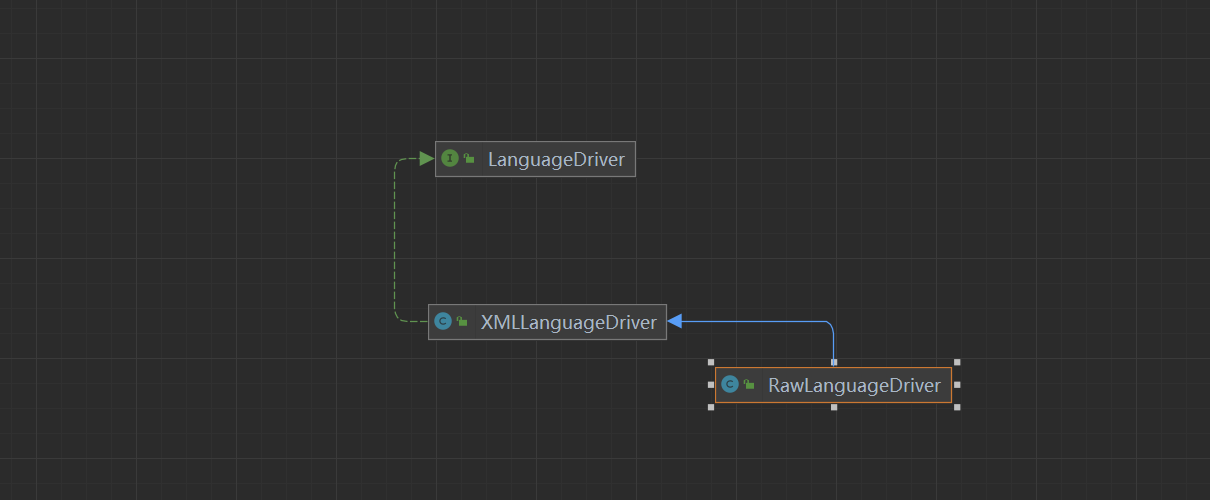
- 返回一个默认的参数处理器通过参数处理器为PreparedStatement设置参数
XMLLanguageDriver
// 返回一个默认的参数处理器
@Override
public ParameterHandler createParameterHandler(MappedStatement mappedStatement, Object parameterObject, BoundSql boundSql) {
return new DefaultParameterHandler(mappedStatement, parameterObject, boundSql);
}
DefaultParameterHandler
public class DefaultParameterHandler implements ParameterHandler {
// 类型处理器注册表
private final TypeHandlerRegistry typeHandlerRegistry;
// MappedStatement对象包含完整的增删改查节点信息
private final MappedStatement mappedStatement;
// 参数对象
private final Object parameterObject;
// BoundSql对象包含SQL语句、参数、实参信息
private final BoundSql boundSql;
// 配置信息
private final Configuration configuration;
public DefaultParameterHandler(MappedStatement mappedStatement, Object parameterObject, BoundSql boundSql) {
this.mappedStatement = mappedStatement;
this.configuration = mappedStatement.getConfiguration();
this.typeHandlerRegistry = mappedStatement.getConfiguration().getTypeHandlerRegistry();
this.parameterObject = parameterObject;
this.boundSql = boundSql;
}
@Override
public Object getParameterObject() {
return parameterObject;
}
/**
* 为语句设置参数
* @param ps 语句
*/
@Override
public void setParameters(PreparedStatement ps) {
ErrorContext.instance().activity("setting parameters").object(mappedStatement.getParameterMap().getId());
// 取出参数列表
List<ParameterMapping> parameterMappings = boundSql.getParameterMappings();
if (parameterMappings != null) {
for (int i = 0; i < parameterMappings.size(); i++) {
ParameterMapping parameterMapping = parameterMappings.get(i);
// ParameterMode.OUT是CallableStatement的输出参数已经单独注册。故忽略
if (parameterMapping.getMode() != ParameterMode.OUT) {
Object value;
// 取出属性名称
String propertyName = parameterMapping.getProperty();
if (boundSql.hasAdditionalParameter(propertyName)) {
// 从附加参数中读取属性值
value = boundSql.getAdditionalParameter(propertyName);
} else if (parameterObject == null) {
value = null;
} else if (typeHandlerRegistry.hasTypeHandler(parameterObject.getClass())) {
// 参数对象是基本类型则参数对象即为参数值
value = parameterObject;
} else {
// 参数对象是复杂类型取出参数对象的该属性值
MetaObject metaObject = configuration.newMetaObject(parameterObject);
value = metaObject.getValue(propertyName);
}
// 确定该参数的处理器
TypeHandler typeHandler = parameterMapping.getTypeHandler();
JdbcType jdbcType = parameterMapping.getJdbcType();
if (value == null && jdbcType == null) {
jdbcType = configuration.getJdbcTypeForNull();
}
try {
// 此方法最终根据参数类型调用java.sql.PreparedStatement类中的参数赋值方法对SQL语句中的参数赋值
typeHandler.setParameter(ps, i + 1, value, jdbcType);
} catch (TypeException | SQLException e) {
throw new TypeException("Could not set parameters for mapping: " + parameterMapping + ". Cause: " + e, e);
}
}
}
}
}
}
后面的为执行器设置一个默认的resultSetHandler结果处理器我就不说了
1.7 拿到StatementHandler具体的执行
- 获取数据库连接执行sql语句封装结果返回
Configuration
// 返回一个StatementHandler对象
public StatementHandler newStatementHandler(Executor executor, MappedStatement mappedStatement, Object parameterObject, RowBounds rowBounds, ResultHandler resultHandler, BoundSql boundSql) {
StatementHandler statementHandler = new RoutingStatementHandler(executor, mappedStatement, parameterObject, rowBounds, resultHandler, boundSql);
statementHandler = (StatementHandler) interceptorChain.pluginAll(statementHandler);
return statementHandler;
}
通过RoutingStatementHandler返回一个PreparedStatementHandler对象
PreparedStatementHandler
@Override
public int update(Statement statement) throws SQLException {
PreparedStatement ps = (PreparedStatement) statement;
ps.execute();
// 返回影响条数
int rows = ps.getUpdateCount();
// 参数对象
Object parameterObject = boundSql.getParameterObject();
// 主键自增器
KeyGenerator keyGenerator = mappedStatement.getKeyGenerator();
// 后置执行主键自增
keyGenerator.processAfter(executor, mappedStatement, ps, parameterObject);
return rows;
}
SimpleExecutor
@Override
public int doUpdate(MappedStatement ms, Object parameter) throws SQLException {
Statement stmt = null;
try {
Configuration configuration = ms.getConfiguration();
StatementHandler handler = configuration.newStatementHandler(this, ms, parameter, RowBounds.DEFAULT, null, null);
stmt = prepareStatement(handler, ms.getStatementLog());
return handler.update(stmt);
} finally {
closeStatement(stmt);
}
private Statement prepareStatement(StatementHandler handler, Log statementLog) throws SQLException {
Statement stmt;
Connection connection = getConnection(statementLog);
stmt = handler.prepare(connection, transaction.getTimeout());
handler.parameterize(stmt);
return stmt;
}
@Override
public int doUpdate(MappedStatement ms, Object parameter) throws SQLException {
Statement stmt = null;
try {
Configuration configuration = ms.getConfiguration();
StatementHandler handler = configuration.newStatementHandler(this, ms, parameter, RowBounds.DEFAULT, null, null);
stmt = prepareStatement(handler, ms.getStatementLog());
return handler.update(stmt);
} finally {
closeStatement(stmt);
}
}
- 从Connection中创建一个Statement
- 为Statement绑定实参
// 准备语句
private Statement prepareStatement(StatementHandler handler, Log statementLog) throws SQLException {
Statement stmt;
// 获取连接
Connection connection = getConnection(statementLog);
// 从Connection中创建一个Statement
stmt = handler.prepare(connection, transaction.getTimeout());
// 为Statement绑定实参,这就要参考具体的实现类 这里就是PreparedStatementHandler
handler.parameterize(stmt);
// 返回 Statement
return stmt;
}
- 交个处理器执行handler.update(stmt)返回结果
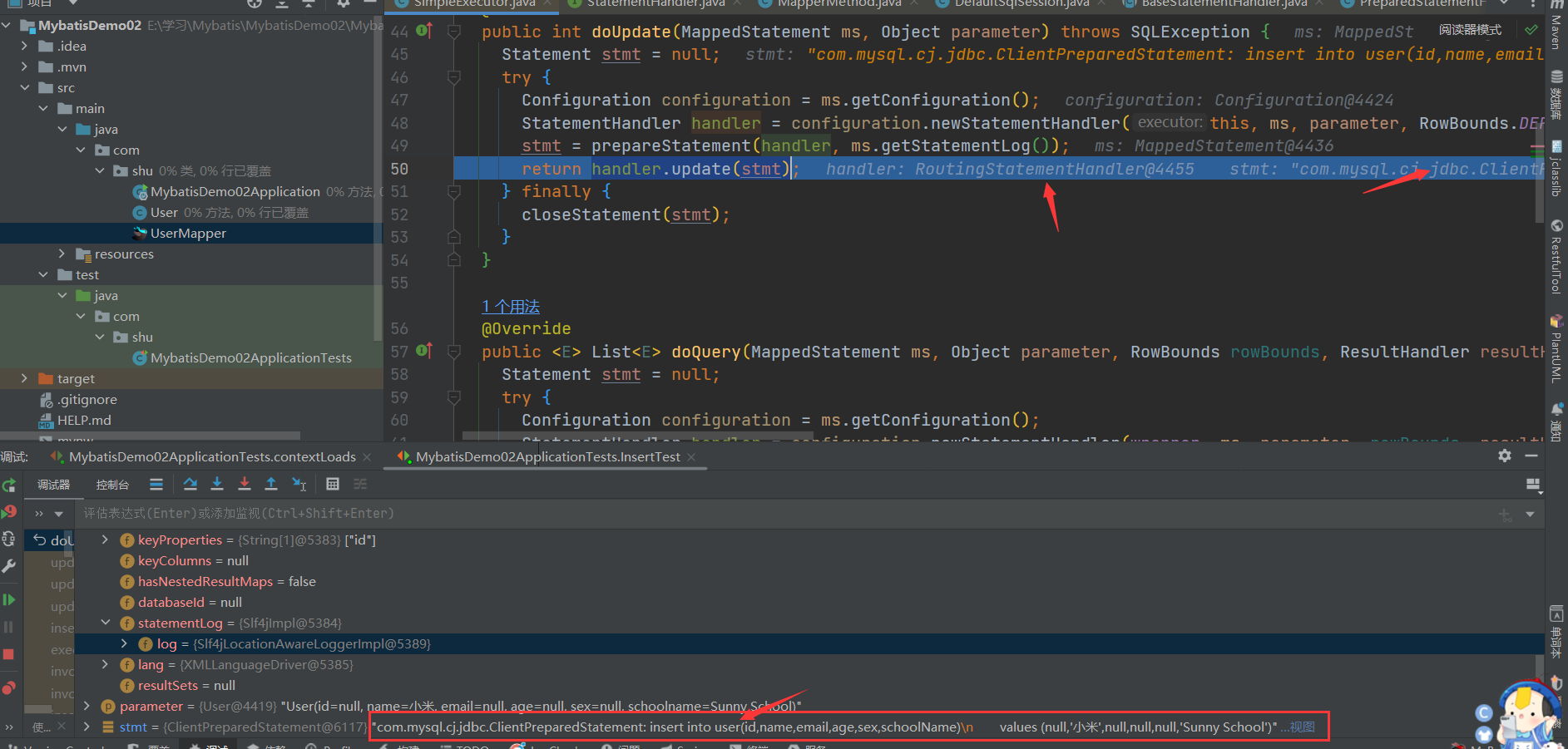
- 更新语句
@Override
public int update(Statement statement) throws SQLException {
PreparedStatement ps = (PreparedStatement) statement;
ps.execute();
int rows = ps.getUpdateCount();
Object parameterObject = boundSql.getParameterObject();
KeyGenerator keyGenerator = mappedStatement.getKeyGenerator();
keyGenerator.processAfter(executor, mappedStatement, ps, parameterObject);
return rows;
}
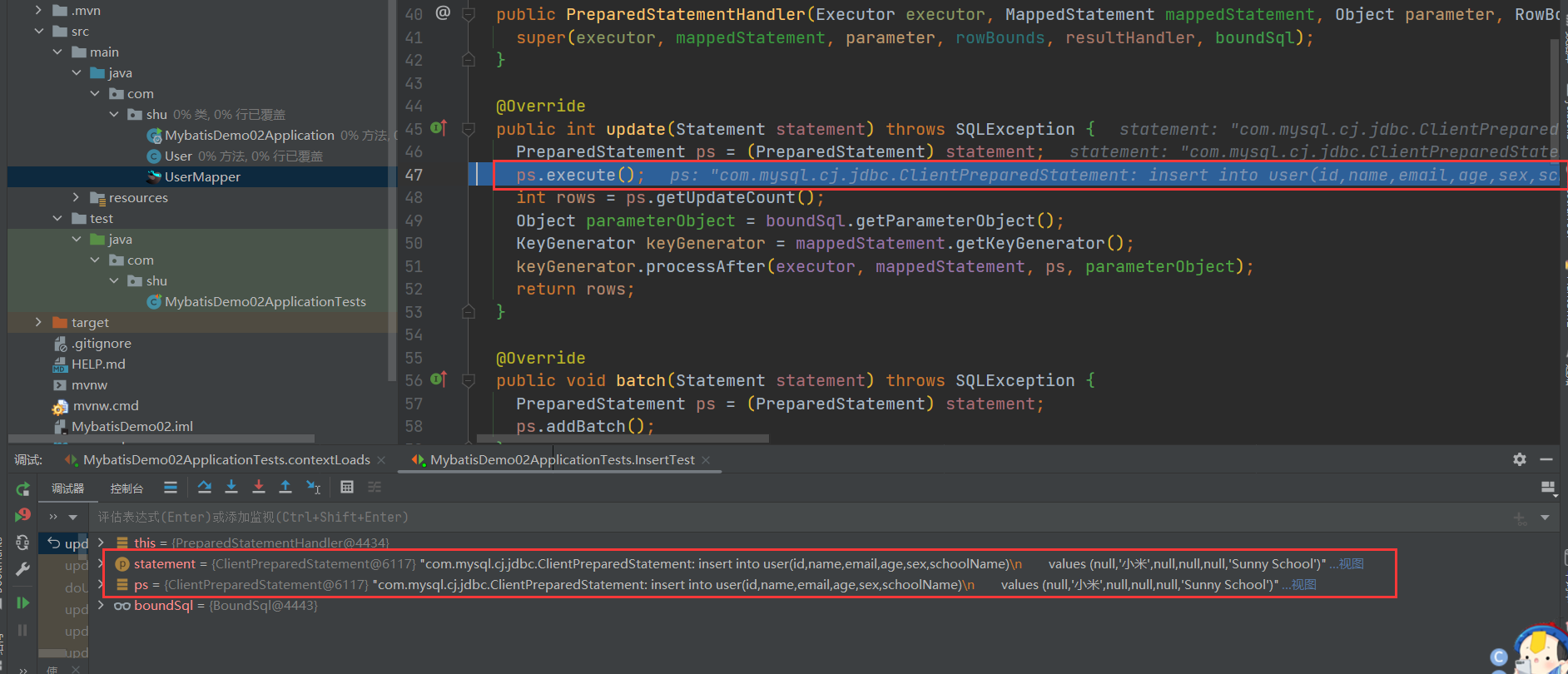
PreparedStatement.execute() 是用于执行预编译的 SQL 语句的方法。它可以通过传递参数来执行带有占位符的预编译语句。
这个方法的返回值是一个布尔值表示该语句是否返回结果集。如果返回 true则表示该语句返回了结果集如果返回 false则表示该语句没有返回结果集。
例如
PreparedStatement stmt = conn.prepareStatement("SELECT * FROM users WHERE name=?");
stmt.set String(1, "John");
boolean hasResultSet = stmt.execute();
在这个例子中我们创建了一个预编译的语句并且使用 setString 方法为第一个占位符设置了参数。然后我们使用 execute 方法执行该语句并将返回值保存在 hasResultSet 变量中。

